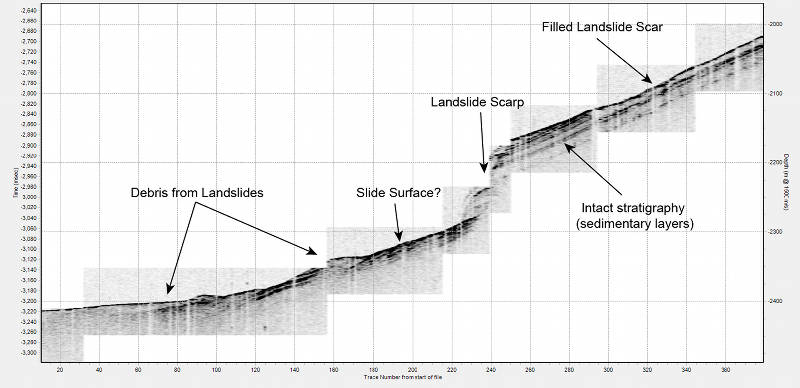
By Jason D. Chaytor - Research Geologist, U.S. Geological Survey
September 24, 2014

Figure 1. Sub-bottom profiling system mapping buried sediments and rock. Image courtesy of the U.S. Geological Survey. Download larger version (jpg, 726 KB).
In addition to the multibeam mapping system on NOAA Ship Okeanos Explorer, there are a number of other mapping/geophysical instruments that are used to map geology below the seafloor surface and to image the water column. Sub-bottom profiling (SBP), which we sometimes also call chirp (based on its operating mode), 3.5 kHz (an operating frequency of the equipment), Knudsen (the instrument manufacturer) and high-resolution seismic profiling, is a geophysical surveying technique that often occurs as part of the mapping operations.
Okeanos Explorer and many other research/survey vessels use this technology to produce cross sections or vertical slices of the upper tens to hundreds of meters of the sediments below the seafloor. A combination of multibeam bathymetry data and sub-bottom profiles provides a highly four-dimensional view (the fourth dimension being time) of an area that can be used to investigate a variety of geological processes.
Like the multibeam system on Okeanos, the sub-bottom profiling system operates using sound energy. But, unlike the multibeam system which is used to map the surface of the seafloor, the energy emitted by the SBP system is a low frequency that penetrates through the seafloor and is reflected back up to the ship when it encounters different types of buried sediments and rock (Figure 1).
The sub-bottom profiling system installed in the hull of Okeanos is a type of ‘chirp’ instrument. Instead of emitting sound at a fixed frequency (rate at which a full sound wave is transmitted), a chirp system sweeps through a wide-frequency band (three to four kilohertz wide) that allows the outgoing signal to be more powerful and able to resolve geologic layering/features at a higher resolution.

Figure 2. Map of landslide location, morphology, and sedimentary structure. Image courtesy of the U.S. Geological Survey. Download larger version (jpg, 360 KB).
The ability of the SBP system to penetrate the seafloor and the sub-seafloor materials is a function of engineering plus prevailing oceanographic and geologic conditions, including the power of the outgoing signal, sea surface weather conditions, morphology of the seafloor, and the composition of the sediments (the acoustic signal penetrates silts and clays better than sand and other coarse sediments).
SBP data collected by Okeanos during this and previous exploration legs in the Atlantic and Gulf of Mexico are being used for a variety of scientific investigations. At the U.S. Geological Survey, we are using these data to map the location, morphology, and sedimentary structure of submarine landslides (Figure 2); to identify the location and pathways of gas in the shallow-subsurface; to understand the mechanisms and pathways of sediment transport from shallow water to the deep-sea; and to guide the placement of equipment for collecting sediment cores.
Sub-bottom profiles, coupled with other geophysical data (bathymetry, backscatter, and other forms of seismic reflection profiling; click here for more information about seismic mapping techniques) and physical samples (sediment cores/grabs, rock samples) allow for a fully integrated and detailed view of the marine geological environment.